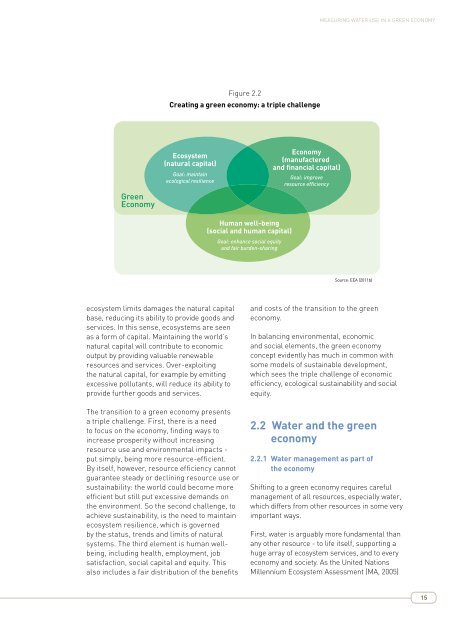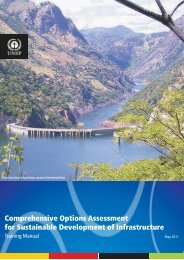MEASURING WATER USE IN A GREEN ECONOMY - UNEP
MEASURING WATER USE IN A GREEN ECONOMY - UNEP
MEASURING WATER USE IN A GREEN ECONOMY - UNEP
Create successful ePaper yourself
Turn your PDF publications into a flip-book with our unique Google optimized e-Paper software.
Measuring water use in a green economy<br />
Figure 2.2<br />
Figure 2.2<br />
Creating a green economy: a triple challenge<br />
Creating a green economy: a triple challenge<br />
Green<br />
Economy<br />
Ecosystem<br />
(natural capital)<br />
Goal: maintain<br />
ecological resilience<br />
Economy<br />
(manufactered<br />
and financial capital)<br />
Goal: improve<br />
resource efficiency<br />
Human well-being<br />
(social and human capital)<br />
Goal: enhance social equity<br />
and fair burden-sharing<br />
Source: EEA (2011b)<br />
ecosystem limits damages the natural capital<br />
base, reducing its ability to provide goods and<br />
services. In this sense, ecosystems are seen<br />
as a form of capital. Maintaining the world’s<br />
natural capital will contribute to economic<br />
output by providing valuable renewable<br />
resources and services. Over-exploiting<br />
the natural capital, for example by emitting<br />
excessive pollutants, will reduce its ability to<br />
provide further goods and services.<br />
The transition to a green economy presents<br />
a triple challenge. First, there is a need<br />
to focus on the economy, finding ways to<br />
increase prosperity without increasing<br />
resource use and environmental impacts -<br />
put simply, being more resource-efficient.<br />
By itself, however, resource efficiency cannot<br />
guarantee steady or declining resource use or<br />
sustainability: the world could become more<br />
efficient but still put excessive demands on<br />
the environment. So the second challenge, to<br />
achieve sustainability, is the need to maintain<br />
ecosystem resilience, which is governed<br />
by the status, trends and limits of natural<br />
systems. The third element is human wellbeing,<br />
including health, employment, job<br />
satisfaction, social capital and equity. This<br />
also includes a fair distribution of the benefits<br />
and costs of the transition to the green<br />
economy.<br />
In balancing environmental, economic<br />
and social elements, the green economy<br />
concept evidently has much in common with<br />
some models of sustainable development,<br />
which sees the triple challenge of economic<br />
efficiency, ecological sustainability and social<br />
equity.<br />
2.2 Water and the green<br />
economy<br />
2.2.1 Water management as part of<br />
the economy<br />
Shifting to a green economy requires careful<br />
management of all resources, especially water,<br />
which differs from other resources in some very<br />
important ways.<br />
First, water is arguably more fundamental than<br />
any other resource - to life itself, supporting a<br />
huge array of ecosystem services, and to every<br />
economy and society. As the United Nations<br />
Millennium Ecosystem Assessment (MA, 2005)<br />
15

















